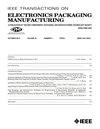Scalability of Roll-to-Roll Gravure-Printed Electrodes on Plastic Foils
IEEE Transactions on Electronics Packaging Manufacturing
Pub Date : 2010-08-19
DOI:10.1109/TEPM.2010.2057512
引用次数: 160
Abstract
Roll-to-roll (R2R) gravure printing is considered to be a leading technology for the production of flexible and low-cost printed electronics in the near future. To enable the use of R2R gravure in printed electronics, the limits of overlay printing registration accuracy (OPRA) and the scalability of printed features with respect to the physical parameters of the gravure system, including given plastic substrates and inks, should be characterized. Important parameters of printed lines include surface roughness, thickness, line widening, and line-edge roughness. To date, there are no comprehensive reports regarding the limits of OPRA and the scalability of printed electrodes, including the control of surface roughness, thickness, line widening, and line-edge roughness using R2R gravure printing. In this paper, we examine ways of evaluating the OPRA limit of our gravure system. We find that OPRA is limited in the web moving direction to 40 μm and in the perpendicular direction to 16 μm, showing the importance of web handling on registration. Furthermore, we demonstrate the scalability of printed electrodes formed using a R2R gravure system to linewidths of 317 μm, with 440 nm thickness, 30 nm of surface roughness and edge waviness of 4 μm on PET foils, and describe optimization strategies to realize improved surface roughness, thickness, line widening, and line-edge roughness for future printed electronics applications.塑料箔上辊对辊凹印电极的可扩展性
卷对卷(R2R)凹版印刷被认为是在不久的将来生产柔性和低成本印刷电子产品的领先技术。为了在印刷电子产品中使用R2R凹印,应该对凹印系统的物理参数(包括给定的塑料基材和油墨)的覆盖印刷配准精度(OPRA)和印刷特征的可扩展性的限制进行表征。印刷线条的重要参数包括表面粗糙度、厚度、线条加宽和线条边缘粗糙度。到目前为止,还没有关于OPRA的限制和印刷电极的可扩展性的综合报道,包括使用R2R凹版印刷控制表面粗糙度,厚度,线条加宽和线边缘粗糙度。本文研究了凹印系统OPRA极限的评价方法。结果表明,在卷材移动方向上,OPRA被限制在40 μm以内,在垂直方向上,OPRA被限制在16 μm以内,表明卷材处理对配准的重要性。此外,我们展示了使用R2R凹印系统形成的印刷电极在PET箔上的可扩展性,线宽为317 μm,厚度为440 nm,表面粗糙度为30 nm,边缘波浪度为4 μm,并描述了优化策略,以实现未来印刷电子应用中改善的表面粗糙度,厚度,线宽和线边缘粗糙度。
本文章由计算机程序翻译,如有差异,请以英文原文为准。
求助全文
约1分钟内获得全文
求助全文

 求助内容:
求助内容: 应助结果提醒方式:
应助结果提醒方式:


